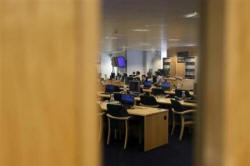 |
|

 British
major threw laptop with sensitive Iraq photos from ferry
British
major threw laptop with sensitive Iraq photos from ferry
[December 04, 2013] LONDON (Reuters) — A British army major disposed of a computer that may have contained photographs of the bodies of Iraqis killed by the British in disputed circumstances by throwing it into the sea from a ferry, a public inquiry heard on Wednesday.
|
James Rands was appearing as a witness at the
Al-Sweady inquiry into allegations that British troops executed
and tortured Iraqis in the aftermath of a battle near the town
of Majar al-Kabir in southern Iraq on May 14, 2004. The allegations, made by local Iraqis and denied by the
soldiers, would, if confirmed by the long-running inquiry, go
down as some of the worst atrocities of the Iraq war. Rands, a captain at the time, was an intelligence officer based
at Camp Abu Naji, a military base where 20 Iraqi bodies were
taken after a fierce gunfight, the British say. Rands took photographs of the bodies which are now one of the
key items of evidence in the inquiry. They are still available
despite the ferry incident because copies had been made of them
prior to the disposal of the originals. The state of the bodies and the reason why they were at Camp Abu
Naji are central issues in the inquiry because Iraqi witnesses
say some of them were taken alive and later executed at the
camp, and that some of the bodies were mutilated. The British say all of the dead were killed on the battlefield
and transported to the camp for the purpose of identification,
because there was a suspicion that an insurgent leader whom they
had been trying to arrest was among them. The wanted man, Naseer Zachra Abd Rufeiq, was suspected of a
central role in the murder of six members of the British Royal
Military Police in Majar al-Kabir the previous year and was
known among the British as "Bravo 1". SENSITIVE MATERIAL The normal practice of the British army is to leave enemy dead
on the battlefield and the decision in this case to transport
them to Camp Abu Naji is one of the controversial issues being
investigated by the inquiry. Rands told the inquiry he had ascertained that Bravo 1 was not
among the dead, but he took photos anyway because he thought
they may be useful for wider intelligence purposes. "I don't think it would ever have occurred to me not to take
those photographs," he said when pressed on why he did so. Asked why five of the bodies had their genitals exposed, Rands
said this was because they were wearing loose-fitting trousers
which had slipped down when the bodies were carried. Asked why
he had not covered them up to preserve their dignity, he said
that would have been "a pretty unpleasant duty". Rands said the computer had later developed a problem and he
became uneasy that he might still have sensitive material, such
as the photographs, on what was his personal laptop. He was not
sure whether the pictures were still stored on the laptop or
not. "I disposed of it by throwing it off a ferry between England and
Germany," he said in his witness statement, adding that this
happened in 2006 and he had been confident copies existed. Ordered by the government in 2009, the Al-Sweady inquiry
conducted three years of preliminary detective work before
beginning oral hearings in March this year. It has cost British
taxpayers 20.3 million pounds ($33.3 million) so far. The inquiry has heard evidence from 60 Iraqi witnesses and will
hear from some 200 British witnesses in hearings expected to
last until next spring. A final report by the chairman, retired
judge Thayne Forbes, is not expected until late 2014. ($1 = 0.6092 British pounds) [By Estelle Shirbon]
|


